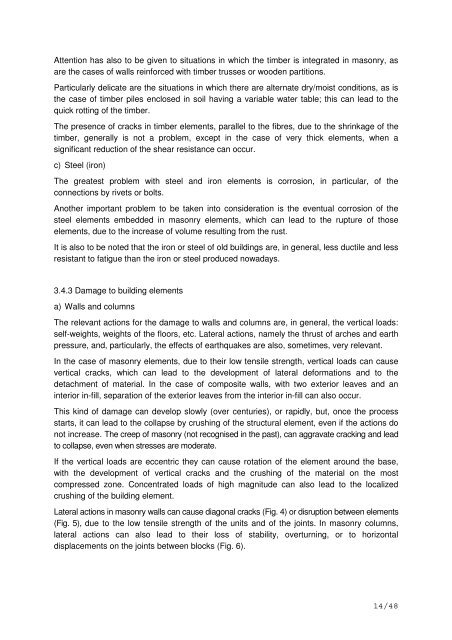Guide for the Structural Rehabilitation of Heritage ... - Test Input
Guide for the Structural Rehabilitation of Heritage ... - Test Input
Guide for the Structural Rehabilitation of Heritage ... - Test Input
You also want an ePaper? Increase the reach of your titles
YUMPU automatically turns print PDFs into web optimized ePapers that Google loves.
Attention has also to be given to situations in which <strong>the</strong> timber is integrated in masonry, asare <strong>the</strong> cases <strong>of</strong> walls rein<strong>for</strong>ced with timber trusses or wooden partitions.Particularly delicate are <strong>the</strong> situations in which <strong>the</strong>re are alternate dry/moist conditions, as is<strong>the</strong> case <strong>of</strong> timber piles enclosed in soil having a variable water table; this can lead to <strong>the</strong>quick rotting <strong>of</strong> <strong>the</strong> timber.The presence <strong>of</strong> cracks in timber elements, parallel to <strong>the</strong> fibres, due to <strong>the</strong> shrinkage <strong>of</strong> <strong>the</strong>timber, generally is not a problem, except in <strong>the</strong> case <strong>of</strong> very thick elements, when asignificant reduction <strong>of</strong> <strong>the</strong> shear resistance can occur.c) Steel (iron)The greatest problem with steel and iron elements is corrosion, in particular, <strong>of</strong> <strong>the</strong>connections by rivets or bolts.Ano<strong>the</strong>r important problem to be taken into consideration is <strong>the</strong> eventual corrosion <strong>of</strong> <strong>the</strong>steel elements embedded in masonry elements, which can lead to <strong>the</strong> rupture <strong>of</strong> thoseelements, due to <strong>the</strong> increase <strong>of</strong> volume resulting from <strong>the</strong> rust.It is also to be noted that <strong>the</strong> iron or steel <strong>of</strong> old buildings are, in general, less ductile and lessresistant to fatigue than <strong>the</strong> iron or steel produced nowadays.3.4.3 Damage to building elementsa) Walls and columnsThe relevant actions <strong>for</strong> <strong>the</strong> damage to walls and columns are, in general, <strong>the</strong> vertical loads:self-weights, weights <strong>of</strong> <strong>the</strong> floors, etc. Lateral actions, namely <strong>the</strong> thrust <strong>of</strong> arches and earthpressure, and, particularly, <strong>the</strong> effects <strong>of</strong> earthquakes are also, sometimes, very relevant.In <strong>the</strong> case <strong>of</strong> masonry elements, due to <strong>the</strong>ir low tensile strength, vertical loads can causevertical cracks, which can lead to <strong>the</strong> development <strong>of</strong> lateral de<strong>for</strong>mations and to <strong>the</strong>detachment <strong>of</strong> material. In <strong>the</strong> case <strong>of</strong> composite walls, with two exterior leaves and aninterior in-fill, separation <strong>of</strong> <strong>the</strong> exterior leaves from <strong>the</strong> interior in-fill can also occur.This kind <strong>of</strong> damage can develop slowly (over centuries), or rapidly, but, once <strong>the</strong> processstarts, it can lead to <strong>the</strong> collapse by crushing <strong>of</strong> <strong>the</strong> structural element, even if <strong>the</strong> actions donot increase. The creep <strong>of</strong> masonry (not recognised in <strong>the</strong> past), can aggravate cracking and leadto collapse, even when stresses are moderate.If <strong>the</strong> vertical loads are eccentric <strong>the</strong>y can cause rotation <strong>of</strong> <strong>the</strong> element around <strong>the</strong> base,with <strong>the</strong> development <strong>of</strong> vertical cracks and <strong>the</strong> crushing <strong>of</strong> <strong>the</strong> material on <strong>the</strong> mostcompressed zone. Concentrated loads <strong>of</strong> high magnitude can also lead to <strong>the</strong> localizedcrushing <strong>of</strong> <strong>the</strong> building element.Lateral actions in masonry walls can cause diagonal cracks (Fig. 4) or disruption between elements(Fig. 5), due to <strong>the</strong> low tensile strength <strong>of</strong> <strong>the</strong> units and <strong>of</strong> <strong>the</strong> joints. In masonry columns,lateral actions can also lead to <strong>the</strong>ir loss <strong>of</strong> stability, overturning, or to horizontaldisplacements on <strong>the</strong> joints between blocks (Fig. 6).14/48
















